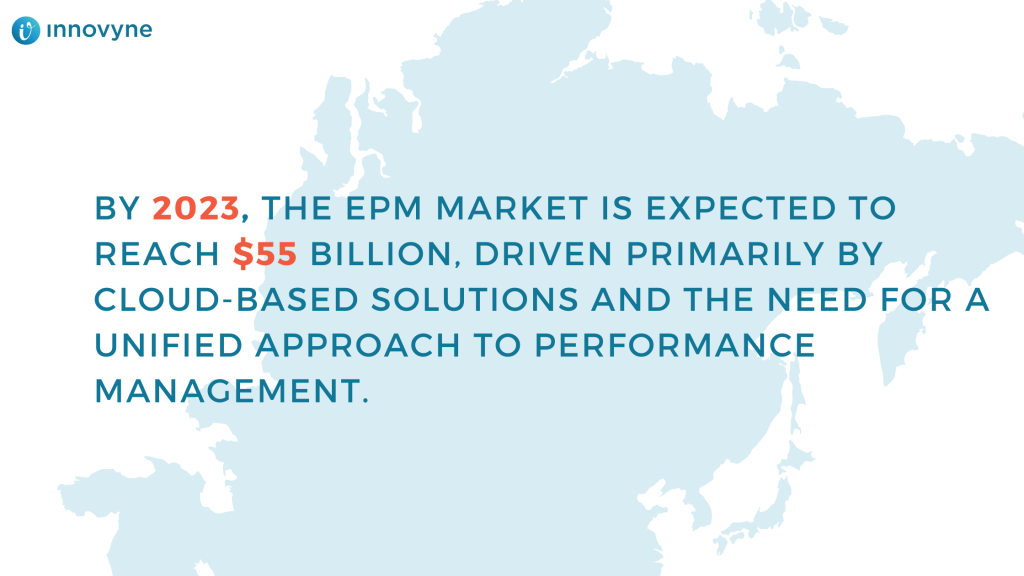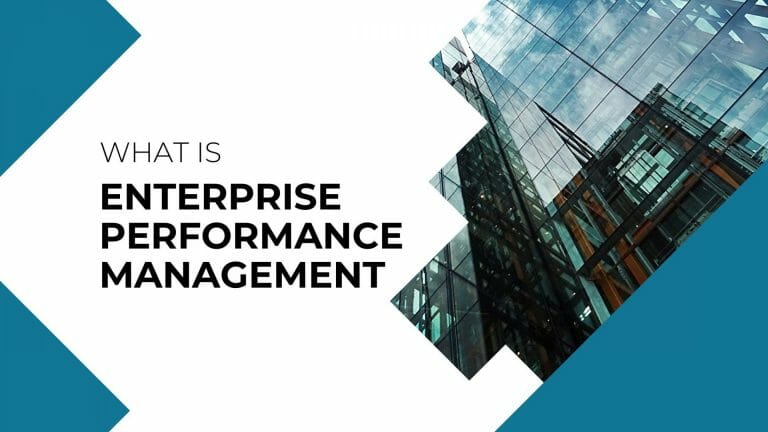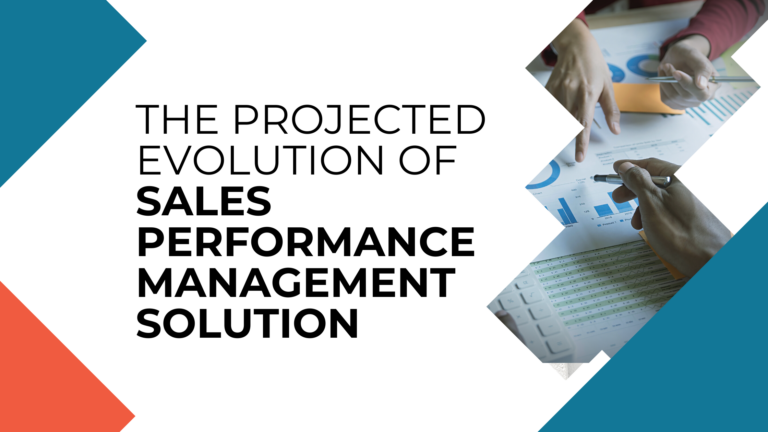Today’s organizations are in a state of continuous change. They need to transform business processes, innovate faster and deliver an excellent customer experience.
Enterprise performance management (EPM) can help IT leaders improve visibility into critical business processes, make decisions faster and increase responsiveness.
This is made possible by embedding analytics in their organization’s core through cloud-based applications that connect all levels of employees to real-time information on how well their company is doing financially, strategically, or operationally.
EPM helps companies do three things:
- Improve financial management, reduce risks and avoid surprises.
- Provide insights to decision-makers.
- And provide feedback loops for better performance across all metrics.
With EPM, businesses become more agile, responsive, and prepared.
Enterprise Performance Management (EPM) provides a single view of an organization’s performance across financial, operational, and tactical metrics.
Executive management can make better strategic decisions about monetizing new opportunities or divesting existing ones by applying business intelligence to the entire enterprise, not just data from one department.
Mid-level managers gain access to actionable information that lets them focus on driving revenue growth, controlling costs, minimizing risks, and satisfying customers.
And finally, line employees at all levels benefit from having easy access to real-time information needed for daily tasks such as planning work activities or making informed decisions about their role in achieving company goals.
EPM applications are deployed on-premise or via cloud-based solutions with analytics embedded inside the business applications. Applications such as sales, marketing, or close financial tools provide users with built-in reports and analysis and collaboration features for an easy and accessible way to access EPM information on demand.
How Enterprise Performance Management Makes Business More Agile?
Enterprise Performance Management (EPM) systems are relatively new concepts used by businesses to measure various aspects of an organization’s performance across different departments, activities, or geographies.
EPM provides businesses with unified information which can be shared across different departments, making it easier for them to make informed decisions.
The most significant advantage of EPM is that it integrates all of an organization’s critical business processes into a single system. This helps employees gain access to the relevant data they need, when they need it, and where they need it without searching or dealing with multiple systems.
This makes decision-making much faster since crucial information is readily available at their fingertips, enabling them to look at overall organizational performance in real-time rather than using past metrics which are heavily influenced by historical trends.
Another significant advantage of implementing next-generation EPM solutions is that businesses get more control over how they want their information displayed, allowing them to customize their dashboards to suit their own needs.
This increased level of control will help employees make better decisions since they are now more aware of how the overall business is performing.
The bottom line is that next-generation EPM solutions will enable companies to operate in real-time, gain full transparency into where they are succeeding or failing and provide them with advanced analytics which helps them understand their performance better.
All this together will enable organizations to make smarter decisions around planning, budgeting, and forecasting for future projects, identifying potential risks, and looking towards new opportunities before it’s too late.
The Three EPM Trends
A lot has happened in the Enterprise Performance Management Market ever since its introduction in 1999 with Oracle Corporation’s ERP (Enterprise Resource Planning) software.
While ERP systems have been widely adopted by several large, medium, and small organizations across different sectors, they still leave a lot to be desired to gain complete visibility into their operations.
For example, most ERP systems are either designed for supply chain management or financial/accounting functionalities, making them incapable of analyzing how end-to-end business processes are performing.
This is where next-generation EPM solutions come into play. They offer businesses an all-inclusive system that helps them gain better insights into their organization’s performance from one unified platform.
Cloud Computing
When we talk about next-generation EPM solutions, the first thing that comes to our minds is cloud computing. There has been a significant transition in the EPM market from on-premise software to cloud computing, enabling businesses to access web-based applications without needing any specialized hardware or infrastructure.
This is a much cheaper option as organizations don’t need to invest in expensive hardware that comes with hefty maintenance contracts and incurs a regular cost of updating software and regular backups.
In addition, cloud offerings are priced very competitively compared to traditional on-premise solutions enabling smaller start-ups and mid-sized businesses to gain quick entry into enterprise Performance Management.
User Experience
The next-generation EPM trend that’s gaining widespread popularity among companies looking towards implementing a next-generation system is user experience. Most employees have been using modern digital tools such as tablets and smartphones to perform their day-to-day tasks.
This is where next-generation EPM comes into play as they offer a much more intuitive user interface than traditional systems, which are made up of bulky web pages that are harder to navigate.
Actionable Insights
The third trend in the Enterprise Performance Management market is built around providing businesses with actionable insights to make better decisions and get ahead of the competition.
Several next-generation EPM platforms provide companies with advanced analytics tools such as predictive analytics, prescriptive analytics, and machine learning capabilities which help them understand their business performance better by analyzing past events and data points.
These analyses help companies predict future trends and make data-driven decisions instead of gut instinct-based, which might not always work out for the best. Over the years, EPM solutions have evolved from simple financial reporting tools to provide businesses with complete visibility into their operations.
Thanks to product vendors who have made considerable investments in this space over time, including Oracle Corporation, SAP SE, Microsoft Corporation, and HCL Technologies, there has been a massive improvement in performance management capabilities offered by new generation software.
So what are you waiting for? If your organization is looking forward to running its business more efficiently and effectively – you need not look further than implementing next-generation Enterprise Performance Management.
It will help you gain control over your entire business operations (not just finance) and make smarter decisions based on real-time data rather than gut feeling.
Enterprise Performance Management Market
The enterprise management market is set for steady growth over the next few years, with an estimated value of $47 billion in 2020. The global industry consists of large corporations using EPM solutions across multiple departments, including finance, marketing, sales, and customer service.

The EPM Market is segmented into three categories based on deployment models:
- On-premise
- Cloud
- Hybrid
Based on organization sizes, there are two types of EPM solutions available for small and medium-sized businesses (SMB’s) and large enterprises, respectively.
Cloud-enabled systems are more widely deployed among SMB’s. In contrast, traditional on-premise software systems are preferred by larger organizations across various industry verticals, including manufacturing, retail, banking, and financial services, the public sector, and more.
On-Premise EPM
The most significant advantage of on-premise systems is that there is no dependency on internet connection meaning employees can perform all their tasks from a single place.
In addition, these solutions offer companies more flexibility as they can choose what features they wish to deploy for their enterprise, which adds up as an advantage over cloud-based installations.
On the downside, however, this increases operations costs by requiring organizations to invest in expensive infrastructure and hire IT personnel for maintenance purposes.
Cloud-enabled EPM
This type of installation allows users to access EPM functionality through a web browser or a thin client, thereby not requiring any infrastructure investment. As most clouds offer business-grade infrastructure, a cloud-based EPM system is more scalable and reliable than on-premise deployments.
Cloud-based solutions are gaining popularity among SMB’s as they make it easier for companies to implement them without making any upfront investments.
In addition, these solutions come equipped with tools that help employees collaborate better and work from across geographical locations simultaneously, resulting in improved productivity.
In addition to this, organizations can also access a wide variety of industry-specific standard business processes that have been developed over time by product vendors or third-party developers.
Evolution of Enterprise Management
The term “enterprise performance” was first coined by Geoffrey A. Moore in his book ‘The Gorilla Game’ in 1996 and referred to the overall financial performance of a company. For this reason, EPM systems can be used to find bottlenecks and gaps between various business units and teams within an organization.
Traditional approaches focused on “back office” processes such as order entry, invoicing, and billing – there were few tools available for managing customer relationships.
As technology progressed and the Internet became more pervasive, companies offered transactional capabilities such as shopping carts and online ordering that enabled customers to place their orders.
This resulted in better product inventory management across channels (physical stores, websites), leading to demand enterprise resource planning (ERP).
Since growth is a primary goal of most organizations, marketing became central to their management strategy, resulting in the rise of another essential business function: Sales.
Conclusion
Enterprise Performance Management is becoming increasingly important within organizations across all industries to help drive business agility, make data-driven decisions and increase productivity.
However, it is not enough for an organization’s EPM solution to be easy to use. Today’s businesses need to think about future scalability when choosing their tools.
With that in mind, mid-market customers should look for next-generation EPM solutions designed with modern technology (cloud-based) and built on unified architecture. This will ensure their platform can support company growth without costly upgrades down the line.



